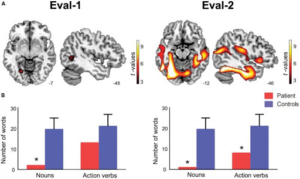Progressive compromise of nouns and action verbs in posterior cortical atrophy
Frontiers in Psychology
Steeb, B., García-Cordero, I., Huizing, M., Collazo, L., Borovinsky, G., Ferrari, J., Martínez Cuitiño, M., Ibáñez, A., Sedeño, L. & García, A. M. (2018). Progressive compromise of nouns and action verbs in posterior cortical atrophy. Frontiers in Psychology 9, 1345. Online: https://bit.ly/2vFLSSD.
En este estudio investigamos cómo el avance de la atrofia cerebral en un caso de atrofia cortical posterior impacta sobre el procesamiento de distintas clases de palabras. En una primera evaluación, cuando el paciente mostraba daño en estructuras posteriores (lóbulo temporal, giro lingual), se registraron déficits en sustantivos pero no en verbos de acción. En cambio, una segunda evaluación realizada dos años después reveló que cuando la atrofia se extendió a circuitos motores (regiones frontales superiores e inferiores, cerebelo, tálamo), los déficits lingüísticos se manifestaron también en lo verbos de acción. Estos resultados ofrecen una perspectiva longitudinal sobre el vínculo distintivo que existen entre vías motoras y las palabras que aluden al movimiento corporal.
Para acceder al artículo hacé click AQUÍ
Progressive compromise of nouns and action verbs in posterior cortical atrophy
Frontiers in Psychology
Steeb, B., García-Cordero, I., Huizing, M., Collazo, L., Borovinsky, G., Ferrari, J., Martínez Cuitiño, M., Ibáñez, A., Sedeño, L. & García, A. M. (2018). Progressive compromise of nouns and action verbs in posterior cortical atrophy. Frontiers in Psychology 9, 1345. Online: https://bit.ly/2vFLSSD.
Processing of nouns and action verbs can be differentially compromised following lesions to posterior and anterior/motor brain regions, respectively. However, little is known about how these deficits progress in the course of neurodegeneration. To address this issue, we assessed productive lexical skills in a patient with posterior cortical atrophy (PCA) at two different stages of his pathology. On both occasions, he underwent a structural brain imaging protocol and completed semantic fluency tasks requiring retrieval of animals (nouns) and actions (verbs). Imaging results were compared with those of controls via voxel-based morphometry (VBM), whereas fluency performance was compared to age-matched norms through Crawford’s t-tests. In the first assessment, the patient exhibited atrophy of more posterior regions supporting multimodal semantics (medial temporal and lingual gyri), together with a selective deficit in noun fluency. Then, by the second assessment, the patient’s atrophy had progressed mainly toward fronto-motor regions (rolandic operculum, inferior and superior frontal gyri) and subcortical motor hubs (cerebellum, thalamus), and his fluency impairments had extended to action verbs. These results offer unprecedented evidence of the specificity of the pathways related to noun and action-verb impairments in the course of neurodegeneration, highlighting the latter’s critical dependence on damage to regions supporting motor functions, as opposed to multimodal semantic processes.
To access the full paper please click here



